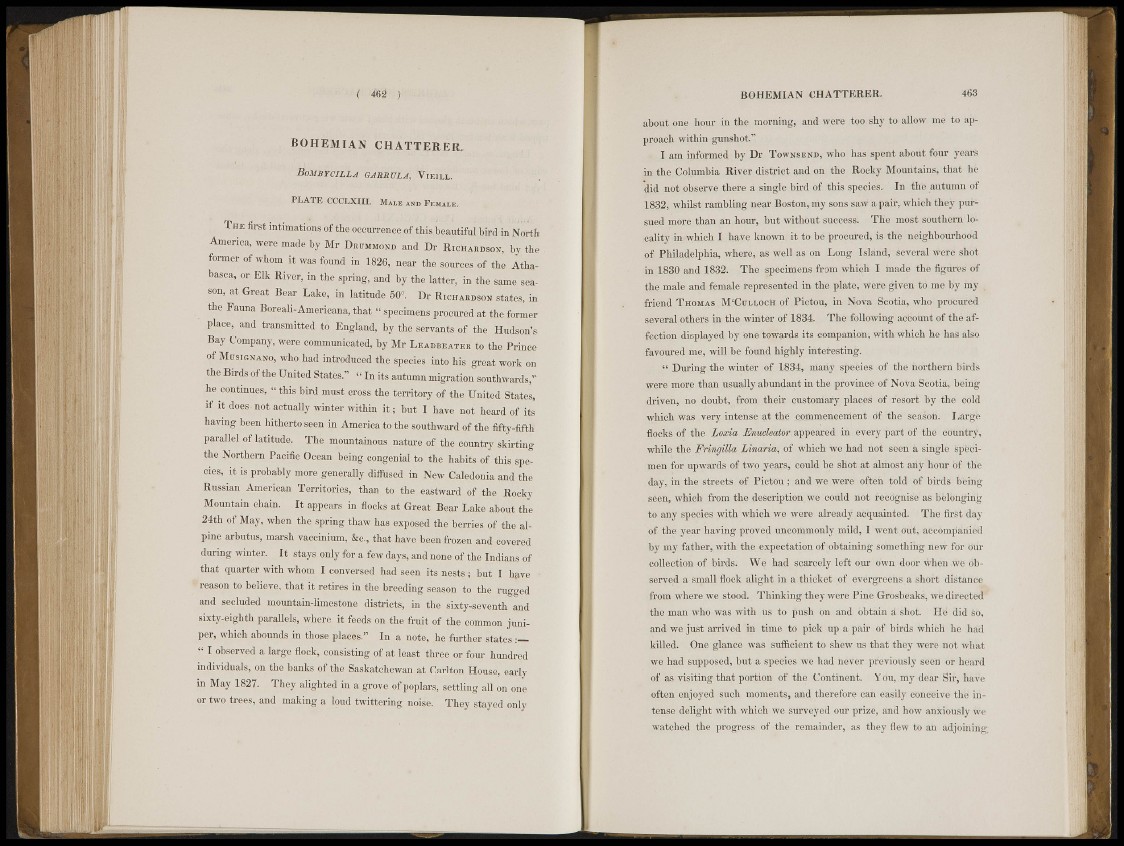
( 46'J )
BOHEMIAN CHATTERER.
IioMBYCII.I.A GARRULA, VlKllX. • ' '•" -
1'i.ATi: ceci.xru. i k a n ^ -
THE first intimations of tho occurrence of this, beautiful bird in North
America, were made by Sir DRDMMOSD and DR RICHARDSON. IJTÌ»
former of whom ft was found in 1826, near the so^c¿¿ of the Athahasofe
or Elk Bfej ^ in the spring/ and by the latter, in the same s i
son, at Great Bear Lake, in latitude 50". Dr RICHARDSON states, in
the Fauna Boreali-Amerieaaa, that; " specimens procured at the former
place, and transmitted to Knglknd, by the servants of the Hudson's:
Hay ('„„.¡.any, wore communicate® by Mr LKABBKATKR to the Prince
of MDSIGWO; who had introduced the species into his great work on
the Birds of the T.mted sSati-s " In its autumn migration southwards,11
hg continues, " this bird must cross the territory of the United States,
if it (iocs - not actually waiter within MiSsfft I have not heard of its
having been hitherto seen in America to the southward of the fifty-fifth
parallel of latitude-. Thè mountainous nature of the country skirting
the Northern Pacific Ocean bei»| congenial to -the hiiiUof this species,
it: is probably more generally diffused in New Caledonia and the
K " s s i a n American territories, than to the eastward 'of the Rocky
Mountain chain. It appears in flocks at Great Boar Lake about the
2«h when the: spring thaw has exposed the berries of ¿ e alpine
arbutus, marsh vaccinium, &c, that have beenfeossen and covered
during winter. It stays.only «o® days, and none of'the Indians <§-
that quarter with whom I conversed had s e S its nests'; but I hfive •
•reason to believe, that it retires in the breeding season to the., rugged
and secluded mountain-limestone districts, in the sixty-seventh and
sixty-eighth parallels, where í | feeds on the fstiiit; of the common juni
per* which abounds: in those places " In a note, lie further states :—
" I observed a large flock, consisting of at least three or four hundred
individuals, on the banks of the Saskatchewan at Carlton House, early
in May 1827. They alighted in a grove of poplars, settling all on one
or two trees, and making a loud twittering noise. They stayed only
B O H E M I A N CHATTERER. 463
about one hour in the morning, and were too shy to allow me to approach
within gunshot.11
- I am informed by Dr TOWNSEND, who has spent about four years
in the, Golumb» River district and oil the Rocky Mountains, that he
"did not observe there a single bird of this species. In the autumn of
1832, whilst rambling neaf Boston, my sons saw a pair, which they pursued
Shore than at; hour, but without success. The most southern locality
in which I have known it to be procured, is the neighbourhood
of- Philadelphia, where,, as well as on Long Island, several were shot
in 1830 and 1832. Th4i§peciij(eii;S. from which I made the figiires of
the male and female represented in the plate; were given to me by mv ,
friend THOMAS M'Ci:i.i,ocir of Pictou, in \ova- Scotia, who procured
several others in the widter of 1834. The following acbount of the affection,
displayed by one towards its companion', with which he haS also
favoured me, will be found highly interesting.
" During the winter of 1834, many species of the northern birds
were more than usually abundant in the province of Nota Scotia, being
driven, no doubt, from their customary places of resort by the cold
which was very intense a,t the c.onimeneenient df the season. Large
flocks of the hoxia Jjnudeutor appeared in every part Of the country,
while |he Fringilla Linwria, of which we had not seen a single SpSSimen
for upwards of two years, could be shot at almost any hour of the
day, in the, streets of Pictou; and we were often told of birds being
seen, which from the description we could not recognise as belonging
to any species with which we were already acquainted; The first day
of the;: year having proved uncommonly mild, I went out. accompanied
by my father, with the. expectation of obtaining something new for Our
collection of birds. We had scarcely left pur own door when we observed
a small iiock alight in a thicket of evergreens a short distance
from where we stood. Thinking they were Pine Grosbeaks, we directocr
the man who was with us to* push on and obtain d shot. He did SO,
and we just arrived in time to pick up a pair of birds which he had
killed. One glance was sufficient to shew us: that they were not what
we had supposed, but a species we had never previously seen or heard
of .JUS visiting that portion of the Continent. You,.my dear Sir, have
often enjoyed such moments, and therefore can easily conceive the intense
delight with which we surveyed our prize, and how anxiously we
watched the progress of-the remainder, as they flew to an adjoining.